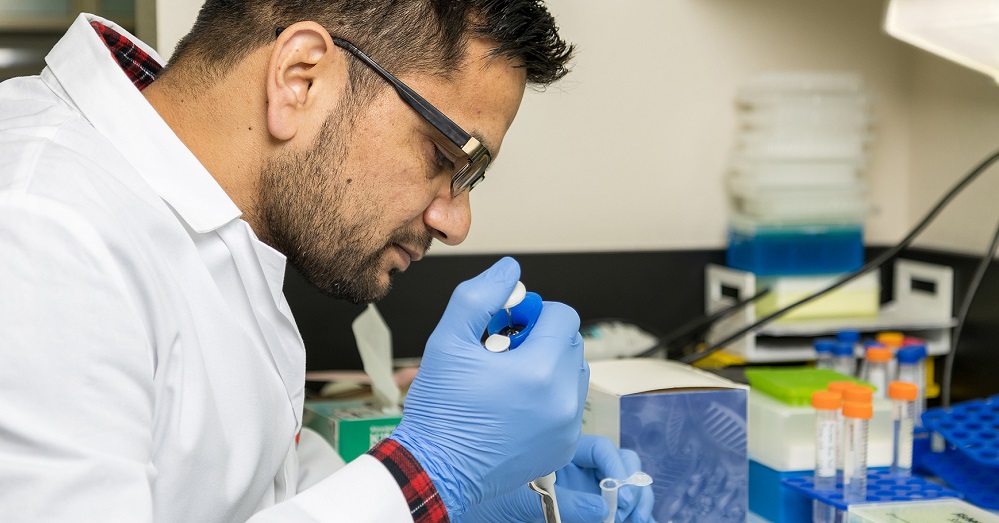Patent Issued to TTUHSC Researchers for Potential Early Detectable Blood-Based Biomarker for Alzheimer’s Disease

P. Hemachandra Reddy, Ph.D.
A United States patent was recently awarded to P. Hemachandra Reddy, Ph.D., and Subodh Kumar, Ph.D., from the Department of Internal Medicine at the Texas Tech University Health Sciences Center School of Medicine. The patent, “MicroRNA-455-3p as a Peripheral Biomarker for Alzheimer’s Disease,” focuses on the development of a novel blood-based biomarker for the early detection of Alzheimer’s disease.
The present invention includes a novel method for identifying an Alzheimer's disease patient prior to reaching the clinical disease classification and is based on increased levels of microRNA-455-3p in a blood, serum or plasma sample obtained from cognitively impaired Alzheimer’s disease patient relative to a cognitively healthy control subject with no clinical evidence of Alzheimer’s disease.
As people age, the gradual loss of cognitive function often signals the onset of Alzheimer’s disease or similar types of dementia. These conditions cause the person to lose some of their intellectual functions such as the ability to contemplate ideas, retain memories and apply reasoning skills.
The prevalence of these age-related and chronic conditions increases each year, and recent studies have shown they disproportionately affect the elderly populations in rural West Texas. Research also suggests that minority communities in rural West Texas often face the greatest incidence of Alzheimer’s disease or other forms of dementia due to being underserved and poor access to appropriate health care services.

Subodh Kumar, Ph.D.
The patented biomarker technology is based on a small, single-stranded, non-coding RNA molecule, called microRNA (miRNA), that helps cells control the kinds and amounts of proteins they make. MicroRNA-455-3p, also known as miR-455-3p, is a member of a broadly maintained miRNA family present on human chromosome 9.
Reddy said the role of miR-455 has been implicated in various normal physiological processes and diseases such as cartilage development, adipogenesis and preeclampsia. “It is also implicated in various cancers such as colon cancer, prostate cancer, hepatocellular carcinoma, renal cancer, oral squamous cancer, skin cancer and non-small cell lung cancer,” Reddy added.
The Reddy laboratory discovered the miR-455-3p biomarker and its therapeutic relevance by conducting a global microarray analysis of serum samples from three groups: Alzheimer’s disease patients; individuals with mild cognitive decline; and healthy patients with no known signs of the disease.
“Our findings unveiled significantly higher levels of miR-455-3p in the Alzheimer’s disease patients relative to the individuals with mild cognitive dysfunctions and the healthy control patients,” Reddy explained. “Further, validation analysis using different kinds of Alzheimer’s disease samples such as serum, postmortem brains, fibroblasts, B-lymphocytes, Alzheimer’s disease cell lines, Alzheimer’s disease mouse models and cerebrospinal fluid cells from Alzheimer’s disease patients confirmed the biomarker potential of miR-455-3p.”

Subodh Kumar, Ph.D.
Reddy’s group believes miR-455-3p may serve as a key biomarker because it is part of the mechanism leading to Alzheimer’s disease, namely it modulates amyloid beta (amyloid-β) protein precursor and amyloid-β levels. Amyloid-β is comprised of peptides of 36–43 amino acids, which are considered the primary component of the amyloid plaques found in the brains of Alzheimer's disease patients. To confirm that amyloid-β protein precursor (AβPP) is a target of miR-455-3p, Reddy and colleagues used a luciferase reporter assay, which is a test used to determine whether or not a protein has the ability to activate or repress the expression of a targeted gene. Further, mouse neuroblastoma were used to establish a protective role of miR-455-3p against amyloid-β-induced toxicities. The findings obtained by Reddy and colleagues suggested that miR-455-3p enhances cell survival and extends lifespan, and further suggested that elevated levels of miR-455-3p reduce Aβ toxicity, enhance mitochondrial biogenesis and synaptic activity, and maintain healthy mitochondrial dynamics.
The next translational step was to understand the function of microRNA-455-3p in whole animals. To accomplish this, the Reddy lab generated both transgenic (TG) and knockout (KO) mouse models of miR-455-3p. They found that mice with overexpressed microRNA-455-3p lived five months longer than wild-type counterparts, whereas depleted microRNA mice lived four months shorter than wild-type mice. A Morris water maze test, which tests a rodent’s special learning, showed improved cognitive behavior, spatial learning and memory in overexpressed miR-455-3p mice relative to age-matched wild-type mice.
“Overall, the overexpressed miR-455-3p in mice displayed protective effects, whereas depleted miR-455-3p exhibited deleterious effects in mice relative to lifespan, cognitive behavior and mitochondrial and synaptic activities,” Reddy said. “Based on these evidences, we cautiously conclude that miR-455-3p is a promising peripheral biomarker and therapeutic candidate for Alzheimer’s disease.”
Related Stories
TTUHSC Cancer Researcher Honored by National Academy of Inventors
C. Patrick Reynolds, M.D., Ph.D., director of the School of Medicine Pediatric Cancer Research Center at TTUHSC, has dedicated his life as a researcher to developing treatments for childhood cancers.
TTUHSC’s Hudson Set to Serve as President for Society of Clinical Research Associates
The Society of Clinical Research Associates (SOCRA) has elected Texas Tech University Health Sciences Center’s (TTUHSC) Catherine Hudson, Dr.P.H., as its president for 2025-2026.
Clinical Research Institute a Source of Pride for Retiring Griswold
Upon his retirement, John Griswold, M.D., reflects on the Clinical Research Institute and what it has achieved.
Recent Stories
TTUHSC Cancer Researcher Honored by National Academy of Inventors
C. Patrick Reynolds, M.D., Ph.D., director of the School of Medicine Pediatric Cancer Research Center at TTUHSC, has dedicated his life as a researcher to developing treatments for childhood cancers.
TTUHSC School of Nursing Celebrates 10 Years of the Veteran to BSN Program
The TTUHSC School of Nursing recognized the 10-year anniversary of the Veteran to Bachelor of Science in Nursing (VBSN) program during the fall 2025 commencement ceremonies held Dec. 13 in Lubbock, Texas.
TTUHSC Dean to be Inducted into the National Academies of Practice as Distinguished Fellow
Gerard E. Carrino, Ph.D., MPH, dean of the TTUHSC Julia Jones Matthews School of Population and Public Health, will be inducted into the National Academies of Practice (NAP) as a Distinguished Fellow of the Public Health Academy.
